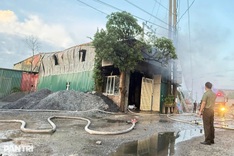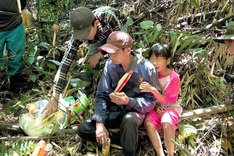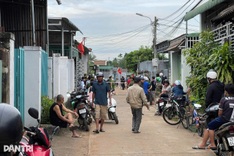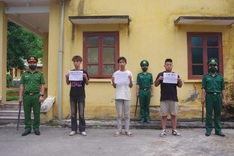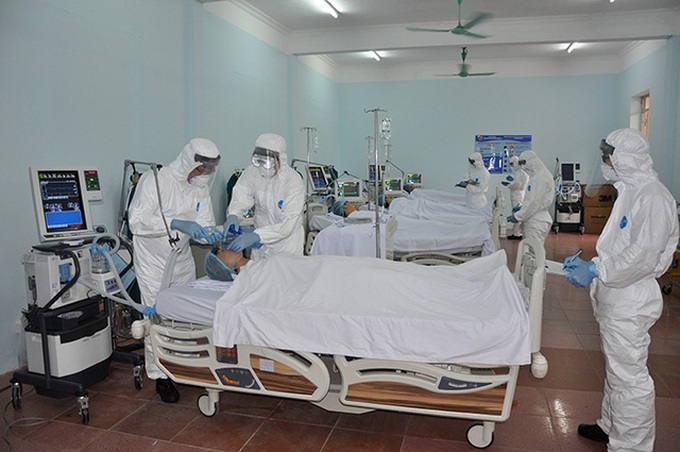
Doctors treat patients at a makeshift hospital during an exercise for COVID-19 prevention in Hanoi, March 4, 2020
As we struggle to find ways to co-operate in this harsh time, individual nations have adopted their own methods to combat the spread, with some countries taking it more seriously than others. This unco-ordinated approach left weak links in our defensive lines. In Europe, one of the regions with the most cases, this a la carte strategy has had tragic consequences. The same thing can be said for the United States, where inadequate intervention by the government, despite seeing how quickly the virus had spread throughout China and Europe, continues to push the situation towards an uncontrollable and deepening crisis. Indeed, many economically developed countries have been completely overwhelmed by the disease, with the number of deaths and newly infected rising dramatically while the authorities struggle to respond. The situation may seem hopeless at times, but if we look at a map of the world, we may find some last traces of light in Southeast Asia. There lies a country that shares a land border China and is heavily dependent on it for trade. In addition, it has a large population and only average medical facilities. However, against all the odds, Vietnam has emerged as one of the most successful countries in this battle against our tiny opponent.
Being a developing country that has only transitioned to a market economy since the 1990s, Vietnam clearly lacks two major weapons in this war: funding and facilities. In terms of the former, governmental funding was already under extreme pressure prior to the coronavirus, due to unresolved problems in the education and transportation systems in major urban centres. Because of this, it is nearly impossible for the Vietnamese government to allocate any more money than they already have done to stop the spread. In addition, regarding facilities, intensive care services in major hospitals are reportedly unable to hold any more than 1,000 people each. The shortage of funding also means that there will not be enough test kits. With all this in mind, an outbreak here would have crippled the nation if it got even the smallest foothold.
So how did they do it? The key lies in early – extremely early – precautions by the authorities. Take a look back to January, before the Vietnamese traditional New Year celebration, when the virus was still restricted to China. Even at this early stage, the authorities foresaw the devastating potential outcomes of the disease. They understood that with the escalating cases recorded at that time, as well as Vietnam’s geographical proximity to China, the country simply could not avoid the virus, so they had to come up with a comprehensive strategy once the disease inevitably came. The government, together with the Ministry of Health, continued to carefully monitor the spread, and required all units in the country to be put on high alert. Many plans for possible outcomes were issued as the country braced for impact.
And when the anticipated came, they were indeed ready. When the first cases appeared on 22 January, the authorities immediately put the patients into isolation. Furthermore, strict quarantine measures were quickly imposed on entire towns or districts where there were confirmed cases, in effect for at least 14 days. At the same time, police created checkpoints controlling movement, while doctors were deployed to check the condition of Covid-19 patients several times a day. Next, they made a detailed list of every possible contact of the infected patients, not just direct interactions but also indirect interactions of up to three or four degrees of separation. This meticulous policy (up to 300 people for each infected case) was implemented to ensure that the situation remained under control. In addition, educational institutions in provinces with confirmed cases, including the capital city of Hanoi, were ordered to shut down completely, from kindergarten to university. Moreover, the government encouraged people to wear masks whenever they went outside, as well as avoid unnecessary travel to the affected areas.
On 25 February, the 16th patient was released from the hospital after testing negative for Covid-19, temporarily clearing Vietnam of the outbreak. However, as the virus grew exponentially elsewhere in the world, travel-related cases started to creep in through Vietnam’s airports. One major case was urgently reported just before midnight on 6 March, when a Vietnamese woman returned from Lombardy, Italy. Although she had been showing severe symptoms, she did not notify the authorities of her travel history and worsening medical condition. After the incident, the government acknowledged that further measures needed to be implemented. A few days later, a new order from the prime minister was issued, requiring that all people entering Vietnam from the Schengen areas, Iran, South Korea and the US must complete a mandatory 14-day quarantine at a central location, instead of just filling in the medical declaration upon entry. This order was later extended to every foreign entry. Soon afterwards, most provinces directed non-essential businesses to be closed until further notice. Travel between cities and provinces was also limited, as police opened checkpoints at regional boundaries. Flights connecting Ho Chi Minh City to Hanoi were also confined to just one per day. In addition, for cases involving complicated travel histories, the health minister called on anyone who had interacted with such individuals to report to a local health station.
Another key to Vietnam’s successful resistance to the spread has been the high-level awareness of its people. Unlike many Europeans and Americans who were unsatisfied about the lockdown, Vietnamese people took the measures rather seriously and complied with them on a large scale. Since the first days of the outbreak, on the streets of Hanoi people were covering their noses and mouths with masks. The citizens were also able to keep close track of the developing news through various media outlets. Responding to the state recommendations, the people of Vietnam showed remarkable fortitude and solidarity, acknowledging their responsibility and following the instructions without complaint. However, this national cohesion was accompanied by some undesirable reactions to the state of emergency. The influx of foreign-related cases, to some extent, sparked panic and fear in a fraction of people. Panic buying, as well as discrimination against foreign people, was also recorded. Worse still, some businesses and individuals took advantage of the situation, spreading fake news about the virus to manipulate the price of certain products for their personal gain. In response, these offending local businesses have been punished by the authorities. Furthermore, the police have been closely monitoring news outlets and have issued severe fines for those responsible for disseminating fake news. Through such actions, people’s lives have been stabilised again.
Vietnam and its people, in addition to the traditional ways of fighting the virus, found some unique methods to raise public awareness. The Ministry of Health requested a famous singer, Min, to rewrite the lyrics of one of her famous songs to remind people to take precautionary steps to prevent the spread of Covid-19. The new version of an old song with ‘catchy’ lyrics became a hit in Vietnam, and has even been trending in many other countries. Isolating in their homes, people came together online to create a dance challenge on Tiktok, with many from all around the world recording their dance to the song.
As the disease has passed its peak, Vietnam is projected to be one of the few winners in the battle against the coronavirus. Certainly, with the hard work demonstrated across Vietnamese society, this will surely be another achievement for the country.

